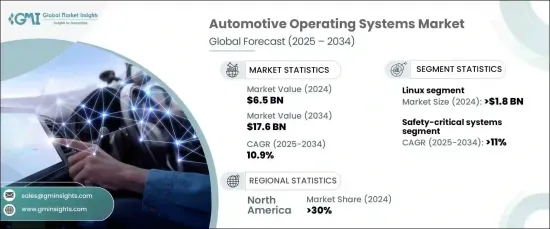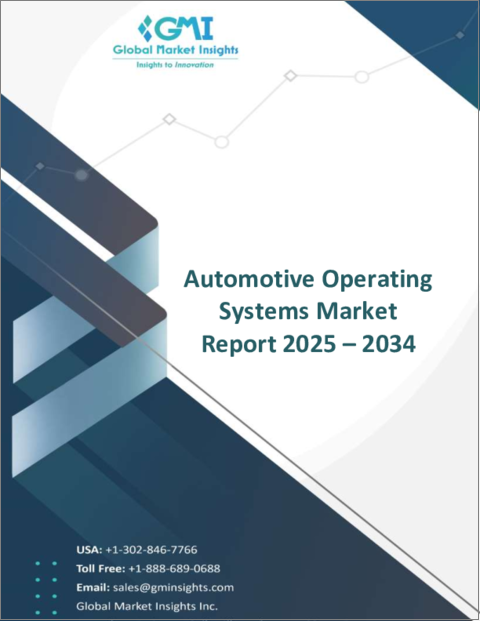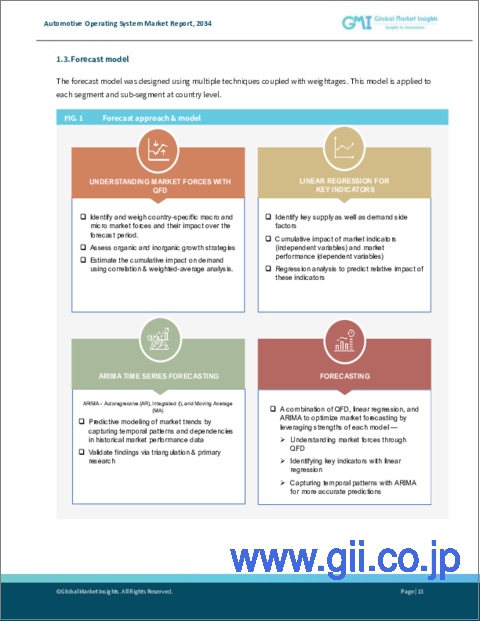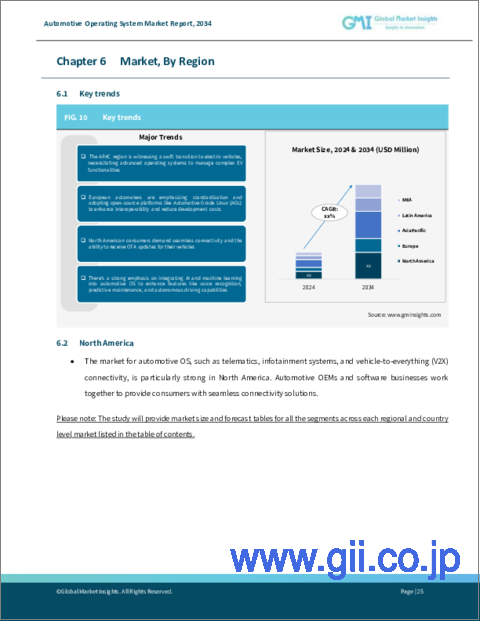|
|
市場調査レポート
商品コード
1666576
自動車用オペレーティングシステム市場の市場機会、成長促進要因、産業動向分析、2025~2034年予測Automotive Operating Systems Market Opportunity, Growth Drivers, Industry Trend Analysis, and Forecast 2025 - 2034 |
||||||
カスタマイズ可能
|
|||||||
| 自動車用オペレーティングシステム市場の市場機会、成長促進要因、産業動向分析、2025~2034年予測 |
|
出版日: 2024年12月03日
発行: Global Market Insights Inc.
ページ情報: 英文 175 Pages
納期: 2~3営業日
|
全表示
- 概要
- 目次
世界の自動車用オペレーティングシステム(OS)市場は、2024年には65億米ドルとなり、2025年から2034年にかけてCAGR 10.9%で成長すると予測されています。
この成長の背景には、自動車ソフトウェアの複雑化、コネクテッドカーや自律走行車の採用拡大、最新の自動車におけるサイバーセキュリティへの注目の高まりがあります。

自動車産業が人工知能や機械学習のような先進技術を統合したソフトウェア定義の自動車へとシフトしているため、市場は大きく拡大しています。メーカーがインテリジェントなコネクテッドシステムの開発を優先するにつれ、柔軟で堅牢なOSの需要が急増しています。この変革により、革新的なソフトウェアプラットフォームと最先端の自動車技術への投資が促進され、自動車の性能、安全性、コネクティビティが向上しています。
| 市場範囲 | |
|---|---|
| 開始年 | 2024 |
| 予測年 | 2025-2034 |
| 開始金額 | 65億米ドル |
| 予測金額 | 176億米ドル |
| CAGR | 10.9% |
OS別では、Linux、Android、QNX、Windows Embedded Automotive 7など、さまざまなプラットフォームが含まれます。2024年には、Linuxがそのオープンソースの性質とカスタマイズ機能によって、大きな市場シェアを獲得し、このセグメントをリードしました。Linuxベースのシステムは、その適応性と拡張性により、車載ソフトウェア開発に好んで選ばれています。これらのシステムは、その信頼性とコミュニティ主導のサポートにより、車載インフォテインメント、自律走行機能、高度な接続ソリューションをサポートするために広く導入されています。
自動車システムに基づき、市場は非安全システムと安全クリティカルシステムに分けられます。安全クリティカルシステム分野は大幅な成長が見込まれており、2025~2034年のCAGRは11%を記録すると予測されています。これらのシステムは、厳しい性能要件とリアルタイム応答性により、車両の安全性と運転効率を確保するために不可欠です。安全クリティカルシステムは、ADAS(先進運転支援システム)、ブレーキメカニズム、ステアリング制御などの重要な機能に役立っています。自動車の安全機能に対するソフトウェアへの依存度が高まるにつれて、フェイルセーフで高性能なオペレーティングシステムの需要は増加の一途をたどっています。
北米の自動車用オペレーティングシステム市場は2024年に30%のシェアを占め、これは同地域がコネクテッドビークルと自律走行車技術を早期に導入したことが要因となっています。同地域は、研究開発への旺盛な投資に支えられた自動車技術革新の世界リーダーです。インフォテインメント、安全性、ADAS(先進運転支援システム)を強化した技術的に先進的な自動車に対する消費者の需要の高まりが、高度な自動車用オペレーティングシステムの必要性を高めています。
自動車用オペレーティングシステム市場は、ソフトウェア駆動型自動車への需要の高まり、コネクティビティ技術の進歩、セーフティ・クリティカルシステムへの注目の高まりにより、急速に拡大しています。自動車メーカーが技術革新と性能を重視する中、消費者の嗜好の進化と技術の進歩に支えられ、市場は今後も成長を続けると思われます。
目次
第1章 調査手法と調査範囲
- 調査デザイン
- 調査アプローチ
- データ収集方法
- 基本推定と計算
- 基準年の算出
- 市場推計の主要動向
- 予測モデル
- 1次調査と検証
- 一次情報
- データマイニングソース
- 市場スコープと定義
第2章 エグゼクティブサマリー
第3章 業界洞察
- エコシステム分析
- サプライヤーの状況
- 部品メーカー
- メーカー
- 流通業者
- 最終用途
- 利益率分析
- 技術とイノベーションの展望
- 特許分析
- 規制状況
- ケーススタディ
- コネクテッドカーのユーザー導入動向
- 影響要因
- 促進要因
- 自動車の安全性と快適性の向上に対する消費者の需要の高まり
- 自動車内の電子部品統合の急増
- 自動車技術と自律走行車開発への投資の拡大
- 高度なユーザーインターフェースのための最先端技術の採用
- 世界の自動車生産台数と乗用車販売台数の伸び
- 業界の潜在的リスク&課題
- 自動車システムの複雑化
- ソフトウェアプラットフォーム開発のための標準プロトコルの欠如
- 促進要因
- 成長可能性分析
- ポーター分析
- PESTEL分析
第4章 競合情勢
- イントロダクション
- 企業シェア分析
- 競合のポジショニング・マトリックス
- 戦略展望マトリックス
第5章 市場推計・予測:OS別、2021年~2034年
- 主要動向
- Android
- Linux
- QNX
- Windows embedded automotive 7
- その他
第6章 市場推計・予測:自動車システム別、2021年~2034年
- 主要動向
- 非安全システム
- Linux
- Android
- その他
- 安全クリティカルシステム
- Autosar
- QNX
- その他
第7章 市場推計・予測:ECU機能別、2021年~2034年
- 主要動向
- パワートレイン
- OS別
- ボディコントロール&コンフォート
- OS別
- インフォテインメント
- OS別
- セーフティ&ADAS
- OS別
- コミュニケーション
- OS別
第8章 市場推計・予測:自動車別、2021年~2034年
- 主要動向
- 乗用車
- コンパクトカー
- 準コンパクトカー
- 中型車
- フルサイズ車
- 商用車
- トレーラー
- バス
- トラック
- 重機
第9章 市場推計・予測:用途別、2021年~2034年
- 主要動向
- インフォテインメントシステム
- ADAS(先進運転支援システム)
- 自律走行
- テレマティクス
- パワートレイン制御
- その他
第10章 市場推計・予測:地域別、2021年~2034年
- 主要動向
- 北米
- 米国
- カナダ
- 欧州
- 英国
- ドイツ
- フランス
- イタリア
- スペイン
- スウェーデン
- アジア太平洋
- 中国
- インド
- 日本
- ニュージーランド
- 韓国
- ラテンアメリカ
- ブラジル
- メキシコ
- アルゼンチン
- 中東・アフリカ
- UAE
- 南アフリカ
- サウジアラビア
第11章 企業プロファイル
- ArcherMind OS Type(Nanjing)
- Automotive Grade Linux
- Autosar
- Baidu
- Bayerische Motoren Werke AG(BMW)
- BlackBerry
- Connected Vehicle Systems Alliance
- Continental AG
- Ford Motor
- General Motors
- Green Hills Software
- Mercedes Benz
- Microsoft
- MontaVista Software
- Neusoft
- Siemens
- Tesla
- Thunder Software OS Type
- Toyota Motor
- Volkswagen AG
- Wind River Systems
The Global Automotive Operating Systems Market was valued at USD 6.5 billion in 2024 and is projected to grow at a CAGR of 10.9% from 2025 to 2034. This growth is fueled by the rising complexity of automotive software, increasing adoption of connected and autonomous vehicles, and heightened focus on cybersecurity in modern vehicles.

The market is witnessing significant expansion as the automotive industry shifts toward software-defined vehicles, integrating advanced technologies like artificial intelligence and machine learning. As manufacturers prioritize developing intelligent, connected systems, the demand for flexible and robust operating systems has surged. This transformation drives investments in innovative software platforms and cutting-edge automotive technologies to improve vehicle performance, safety, and connectivity.
| Market Scope | |
|---|---|
| Start Year | 2024 |
| Forecast Year | 2025-2034 |
| Start Value | $6.5 Billion |
| Forecast Value | $17.6 Billion |
| CAGR | 10.9% |
By operating system, the market includes various platforms such as Linux, Android, QNX, Windows Embedded Automotive 7, and others. In 2024, Linux led the segment with a significant market share, driven by its open-source nature and customization capabilities. The adaptability and scalability of Linux-based systems have made them a preferred choice for automotive software development. These systems are widely deployed to support in-vehicle infotainment, autonomous driving functionalities, and advanced connectivity solutions, thanks to their reliability and community-driven support.
Based on auto systems, the market is divided into non-safety systems and safety-critical systems. The safety-critical systems segment is poised for substantial growth, projected to record a CAGR of 11% during 2025-2034. These systems are vital for ensuring vehicle safety and operational efficiency, with stringent performance requirements and real-time responsiveness. Safety-critical systems help in key functions, including advanced driver-assistance features, braking mechanisms, and steering controls. As vehicles become increasingly reliant on software for safety functions, the demand for fail-safe, high-performance operating systems continues to grow.
North America automotive operating systems market held a 30% share in 2024, driven by the region's early adoption of connected and autonomous vehicle technologies. The region is a global leader in automotive innovation, supported by strong investments in research and development. Growing consumer demand for technologically advanced vehicles with enhanced infotainment, safety, and driver-assistance capabilities boosts the need for sophisticated automotive operating systems.
The automotive operating systems market is expanding rapidly due to the rising demand for software-driven vehicles, advancements in connectivity technologies, and increasing focus on safety-critical systems. As automotive manufacturers emphasize innovation and performance, the market will continue to grow, supported by evolving consumer preferences and technological advancements.
Table of Contents
Chapter 1 Methodology & Scope
- 1.1 Research design
- 1.1.1 Research approach
- 1.1.2 Data collection methods
- 1.2 Base estimates & calculations
- 1.2.1 Base year calculation
- 1.2.2 Key trends for market estimation
- 1.3 Forecast model
- 1.4 Primary research and validation
- 1.4.1 Primary sources
- 1.4.2 Data mining sources
- 1.5 Market scope & definition
Chapter 2 Executive Summary
- 2.1 Industry 3600 synopsis, 2021 - 2034
Chapter 3 Industry Insights
- 3.1 Industry ecosystem analysis
- 3.2 Supplier landscape
- 3.2.1 Component providers
- 3.2.2 Manufacturers
- 3.2.3 Distributors
- 3.2.4 End Use
- 3.3 Profit margin analysis
- 3.4 Technology & innovation landscape
- 3.5 Patent analysis
- 3.6 Regulatory landscape
- 3.7 Case study
- 3.8 User adoption trend of connected vehicles
- 3.9 Impact forces
- 3.9.1 Growth drivers
- 3.9.1.1 Rising consumer demand for enhanced safety and comfort features in vehicles
- 3.9.1.2 Rapid increase in the integration of electronic components within vehicles
- 3.9.1.3 Expanding investments in automotive technology and autonomous vehicle development
- 3.9.1.4 Adoption of cutting-edge technologies for advanced user interfaces
- 3.9.1.5 Growth in global automobile production and passenger vehicle sales
- 3.9.2 Industry pitfalls & challenges
- 3.9.2.1 Increasing automobile system complexities
- 3.9.2.2 Lack of standard protocols to develop software platforms
- 3.9.1 Growth drivers
- 3.10 Growth potential analysis
- 3.11 Porter’s analysis
- 3.12 PESTEL analysis
Chapter 4 Competitive Landscape, 2024
- 4.1 Introduction
- 4.2 Company market share analysis
- 4.3 Competitive positioning matrix
- 4.4 Strategic outlook matrix
Chapter 5 Market Estimates & Forecast, By Operating System, 2021 - 2034 ($Bn)
- 5.1 Key trends
- 5.2 Android
- 5.3 Linux
- 5.4 QNX
- 5.5 Windows embedded automotive 7
- 5.6 Others
Chapter 6 Market Estimates & Forecast, By Auto System, 2021 - 2034 ($Bn)
- 6.1 Key trends
- 6.2 Non-safety system
- 6.2.1 Linux
- 6.2.2 Android
- 6.2.3 Others
- 6.3 Safety-critical system
- 6.3.1 Autosar
- 6.3.2 QNX
- 6.3.3 Others
Chapter 7 Market Estimates & Forecast, By ECU Function, 2021 - 2034 ($Bn)
- 7.1 Key trends
- 7.2 Powertrain
- 7.2.1 By operating system
- 7.3 Body control & comfort
- 7.3.1 By operating system
- 7.4 Infotainment
- 7.4.1 By operating system
- 7.5 Safety & ADAS
- 7.5.1 By operating system
- 7.6 Communication
- 7.6.1 By operating system
Chapter 8 Market Estimates & Forecast, By Vehicle, 2021 - 2034 ($Bn)
- 8.1 Key trends
- 8.2 Passenger cars
- 8.2.1 Compact cars
- 8.2.2 Subcompact cars
- 8.2.3 Mid-size cars
- 8.2.4 Full size cars
- 8.3 Commercial vehicles
- 8.3.1 Trailers
- 8.3.2 Buses
- 8.3.3 Trucks
- 8.3.4 Heavy equipment
Chapter 9 Market Estimates & Forecast, By Application, 2021 - 2034 ($Bn)
- 9.1 Key trends
- 9.2 Infotainment systems
- 9.3 Advanced driver assistance systems
- 9.4 Autonomous driving
- 9.5 Telematics
- 9.6 Powertrain control
- 9.7 Others
Chapter 10 Market Estimates & Forecast, By Region, 2021 - 2034 ($Bn)
- 10.1 Key trends
- 10.2 North America
- 10.2.1 U.S.
- 10.2.2 Canada
- 10.3 Europe
- 10.3.1 UK
- 10.3.2 Germany
- 10.3.3 France
- 10.3.4 Italy
- 10.3.5 Spain
- 10.3.6 Sweden
- 10.4 Asia Pacific
- 10.4.1 China
- 10.4.2 India
- 10.4.3 Japan
- 10.4.4 ANZ
- 10.4.5 South Korea
- 10.5 Latin America
- 10.5.1 Brazil
- 10.5.2 Mexico
- 10.5.3 Argentina
- 10.6 MEA
- 10.6.1 UAE
- 10.6.2 South Africa
- 10.6.3 Saudi Arabia
Chapter 11 Company Profiles
- 11.1 ArcherMind OS Type (Nanjing)
- 11.2 Automotive Grade Linux
- 11.3 Autosar
- 11.4 Baidu
- 11.5 Bayerische Motoren Werke AG (BMW)
- 11.6 BlackBerry
- 11.7 Connected Vehicle Systems Alliance
- 11.8 Continental AG
- 11.9 Ford Motor
- 11.10 General Motors
- 11.11 Google
- 11.12 Green Hills Software
- 11.13 Mercedes Benz
- 11.14 Microsoft
- 11.15 MontaVista Software
- 11.16 Neusoft
- 11.17 Siemens
- 11.18 Tesla
- 11.19 Thunder Software OS Type
- 11.20 Toyota Motor
- 11.21 Volkswagen AG
- 11.22 Wind River Systems





